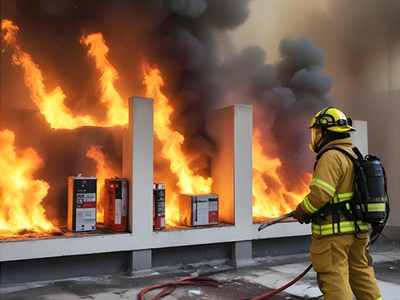Understanding Battery Fires and Their Impact on Today’s Business Landscape

Introduction
Batteries especially Lithium-ion (Li-ion), Nickel Cadmium (NiCad) and other batteries have become an essential component of modern life, powering everything from smartphones and laptops to electric vehicles (EVs) and large-scale energy storage systems. With the global shift toward sustainability, the demand for Li-ion batteries is skyrocketing, thanks to their high energy density, long lifespan, and lightweight design. However, despite their widespread use and numerous benefits, Li-ion batteries pose significant safety risks, with fires and explosions becoming a concerning issue in various industries.
What Causes Lithium-Ion Battery Fires?
Battery fires are typically caused by a phenomenon called thermal runaway. This occurs when a battery cell undergoes rapid heating due to internal or external factors, leading to a cascading failure of the battery's components. This includes majorly four types of battery abuses viz. Electrical Abuse, Mechanical Abuse, Thermal Abuse and Environmental abuse. The primary causes of thermal runaway include:
• Overcharging or Over discharging: When batteries are overcharged, the excessive voltage can cause the electrolyte inside the cell to break down, leading to increased internal temperatures. Similarly, over discharging can cause instability in the cell's chemistry.
• Physical Damage: Li-ion batteries can be damaged by physical impacts or punctures, leading to short circuits within the cell. This short-circuiting can generate heat, which may ignite the electrolyte and cause a fire.
• Manufacturing Defects: Even a minor defect in the separator between the battery's electrodes or contamination during manufacturing can trigger internal short circuits, resulting in thermal runaway.
• Exposure to Heat: Storing or operating Li-ion batteries in environments with high temperatures can degrade the battery’s structure, increasing the risk of fire.
• Internal Short Circuit: This can occur due to dendrite formation (a phenomenon where small metallic lithium deposits form within the cell) or flaws in the design, leading to a rapid increase in temperature.
Once thermal runaway begins, it can be difficult to control because the battery can release flammable gases such as hydrogen and oxygen, which can ignite and fuel the fire. Moreover, once one cell in a battery pack catches fire, the heat can quickly spread to neighboring cells, causing a chain reaction.
Impact on the Business Landscape
• Consumer Electronics: As consumer devices like smartphones, laptops, and tablets rely heavily on Li-ion batteries, manufacturers face significant risks related to battery safety. Incidents like battery fires can lead to costly product recalls, damage to brand reputation, and lawsuits. For instance, one major cell phone manufacturer’s recall in 2016 due to battery fires resulted in substantial financial losses and damaged consumer trust.
• Electric Vehicles (EVs): With the rise of electric mobility, EV manufacturers are keenly aware of the risks posed by battery fires. Though rare, EV fires tend to be highly publicized and can severely impact consumer confidence in electric cars. Safety concerns over battery fires could slow down the EV adoption rate, which is critical for meeting global climate goals.
• Energy Storage Systems (ESS): Li-ion, NiCad and other chemistry batteries are increasingly used in large-scale energy storage systems that help balance supply and demand in the power grid. However, fires in these systems can lead to widespread power outages and environmental damage. Additionally, due to the complex and volatile nature of Li-ion battery fires, traditional firefighting methods are often ineffective.
• Supply Chain and Logistics: Businesses that rely on the transportation and storage of Li-ion batteries face logistical challenges. Regulations around the safe transport of Li-ion batteries, especially via air freight, have become stricter. A battery fire in transit can lead to devastating consequences, including the loss of cargo, significant insurance claims, and interruptions in the global supply chain.
• Insurance and Liability: The increase in incidents involving Li-ion, NiCad battery fires has led to higher insurance premiums and more stringent underwriting policies. Businesses across various sectors now face increased scrutiny over their battery storage, safety, and fire suppression systems. Insurance companies are becoming more selective in providing coverage, especially for industries heavily reliant on Li-ion battery technology.
Fire Suppression Challenges
Battery fires present unique challenges because they burn at extremely high temperatures and release toxic and flammable gases. Traditional fire suppression methods, such as water or foam, are often ineffective and may even exacerbate the situation. None of the existing agent work on battery Fires due to the complex nature and chemistry of these battery fires. The complexity of these fires lies in the fact that thermal runaway must be stopped in all cells simultaneously to prevent re-ignition and mitigation of toxic, flammable and lethal gases.
The F500EA® Solution for Lithium-Ion Battery Fire Suppression
F500 Encapsulator Agent (F500EA®) is a cutting-edge fire and gas suppression agent that addresses many of the limitations of traditional methods when dealing with Li-ion, NiCad and other battery fires. F500EA® works by encapsulating the fuel source, disrupting the fire’s chemical reaction, rapidly reducing the heat, and suppressing toxic, flammable HF and other off-gases which helps to control the fire at its source.
How F500EA® Works:
Heat Reduction: F500EA® cools the Li-ion battery and surrounding area by absorbing a significant amount of heat, preventing the battery from reaching the critical temperature needed to sustain thermal runaway.
Encapsulation: The agent encapsulates the electrolyte and other flammable materials released during a fire, rendering them non-combustible. This prevents the fire from reigniting.
Vapor Mitigation: F500EA® helps suppress the flammable, toxic gases generated during battery fires, such as hydrogen, HF which reduces the chances of secondary ignition.
Conclusion
As Li-ion and other batteries become more integrated into consumer electronics, EVs, and energy storage systems, the risks associated with battery fires pose a significant challenge to businesses globally. From product recalls and damaged brand reputation to logistical concerns and higher insurance premiums, the impact of Li-ion battery fires can be far-reaching.
F500EA® provides a promising solution for mitigating these risks, offering a more effective method for controlling and extinguishing Li-ion battery fires compared to traditional firefighting techniques. By encapsulating the flammable materials and rapidly reducing the temperature, F500EA is a viable solution that can help businesses manage the threat of Li-ion battery fires, ensuring safer operations across industries that rely on this indispensable technology.
Incorporating fire suppression systems like F500EA® into safety protocols will be critical as businesses continue to expand their use of Li-ion batteries, protecting assets, employees, and the environment from potentially catastrophic incidents.
FIRETECH HAZARD CONTROL TECHNOLGIES INDIA PVT LTD.
Web - www.firetechhct.com
Email - sales@firetechhct.com





.png)








